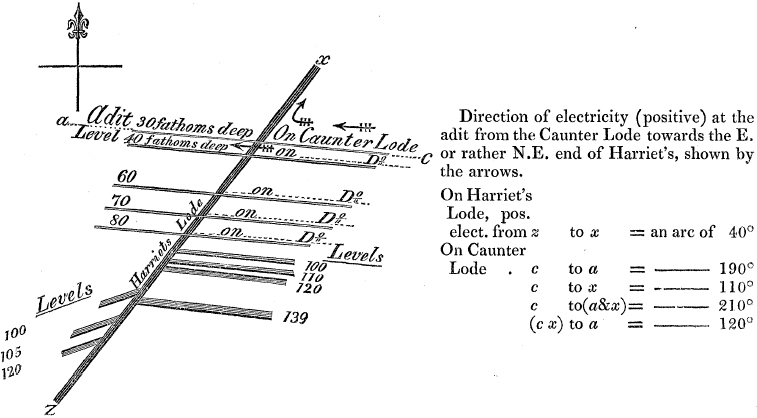[page] 399
XXV. On the electro-magnetic properties of metalliferous veins in the mines of Cornwall. By ROBERT WERE FOX of Falmouth. Communicated by the President.
Read June 10th, 1830.
IN one of my communications to the Cornwall Geological Society on the high temperature of the interior of the earth, I ventured to express a belief that mineral veins, and the internal heat, are connected with electrical action. This opinion, founded as it was on the curious arrangement of the veins, &c. in primitive rocks, I have had the satisfaction to find confirmed by experiments made in some of the mines of Cornwall; and, I doubt not that the existence of electricity in metalliferous veins similarly circumstanced, and capable of conducting it, will prove to be as universal a fact, as the progressive increase of temperature under the earth's surface is now admitted to be, much as my conclusions on this point were at one time controverted.
In my first experiment I did not succeed in detecting any electricity; but in my second I had the gratification to observe considerable electrical action.
My apparatus consisted of small plates of sheet copper, which were fixed in contact with ore in the veins by copper nails, or pressed closely against it by wooden props, stretched across the "levels" or galleries. Between two of these plates at different stations, and a galvanometer*, a communication was made by means of copper wire one-twentieth of an inch in diameter, which was at first coated with sealing-wax; but afterwards this precaution was dispensed with.
* It may be proper to describe the galvanometer employed in making many of my electro-magnetic experiments. The magnetic needle was three inches and a quarter long, one-eighth of an inch wide, and one-twenty-eighth thick. It was inclosed in a box four inches square and one inch in depth, having a plated copper wire one-fiftieth of an inch in diameter coiled round it twenty-five times. No magnet was used to neutralize the terrestrial polarity. In my earlier experiments a less delicate galvanometer was employed.
MDCCCXXX. 3 F
[page] 400
The accompanying sketches are intended to represent the plans adopted, and the results obtained in various mines, and under different circumstances. In some instances nearly 300 fathoms of copper wire were employed*.
The intensity of the electro-magnetic action differed greatly in different places:—in some cases the deviation of the needle was inconsiderable, in others it went completely round the circle. In general it was greater, cæteris paribus, in proportion to the greater abundance of copper ore in the veins, and in some degree perhaps to the depth of the stations;—and where there was little or no ore, there was little or no action. Hence it seems likely that electro-magnetism may become useful to the practical miner in determining with some degree of probability at least, the relative quantity of ore in veins, and the directions in which it most abounds.
When the distance of the plates from each other in a horizontal direction was only a few fathoms, and the copper ore between them was plentiful, and uninterrupted by non-conducting substances, or the workings in the mine, no action occurred, owing no doubt to the good conducting power of the vein; but where a cross vein of quartz or clay happened to be between the plates under similar circumstances, the action was usually great.
When the communication was established between two plates at different depths on the same vein, or between different veins, whether at the same level or otherwise, the electrical action was in general the most decisive. In fact, veins which in some instances were almost destitute of ore, and did not affect the needle per se, did so, though perhaps only in a slight degree, when electrical communications were made between them.
It will be seen that the direction of the positive electricity was in some cases from east to west, and in others from west to east; and when parallel veins were compared, its general tendency was, I think, from north to south, though in several instances it was the reverse. In veins having an underlie towards
* I am indebted to the kindness of my brother, LEWIS FOX, for the experiments referred to in Fig. 3, 13, & 22; to W. J. HENWOOD for those in Fig. 8, 25, & 26, and to RICHARD TREGASKIS for those represented in Fig. 16, 17, & 27. They moreover all assisted me materially on several occasions in making my experiments, especially my brother, who was my companion in most of my descents into the mines. To the various mine agents I am also under particular obligations, for their great attentions and personal assistance; some of them having remained with us underground ten or eleven hours together.
[page] 401
the north, the east was commonly positive with respect to the west; but in veins dipping towards the south, the contrary was observed, with one exception only, and that under rather unusual circumstances. (See Fig. 27.) In comparing the relative states of veins at different depths, the lower stations appeared to be negative to the upper; but exceptions sometimes occurred when a cross vein of quartz or clay intervened between the plates, and the higher one was on the negative side with respect to the horizontal currents. (See Fig. 8. & 12.)
In such cases it may be supposed that there is an accumulation of electricity in different states, on the opposite sides of the non-conducting vein. Such intersections of ore veins, and their being often very rich to a great depth in one direction and not in another, added to their varying underlie at different depths, which is not unfrequently reversed, may tend to produce apparent anomalies in experiments of this nature.
At Huel Jewel mine, I obtained results between a heap of copper ore at the surface, and a plate fixed at different depths against the ore in the vein; the latter becoming more negative, in proportion to the depth at which it was placed. Piles of copper ore at the surface did not act on the needle when tried together, independently of veins, nor was it to be anticipated that they would.
It is not improbable that the progressive increase of negative electricity observed in descending into our mines, if hereafter confirmed, may be found to be connected with the progressive increase of temperature. I have not, however, discovered any distinct connection between them at the same level, but then the differences of temperature are comparatively small. Nor does the electricity appear to be influenced by the presence of the workmen and candles, or by the explosion of gunpowder, although some veins of copper ore were blasted on different occasions in the immediate vicinity of the copper plates. And at a very productive copper vein in Great St. George Mine, the ground is so soft that gunpowder is not used; yet the needle was powerfully acted upon by the electricity it contained. On this occasion, as well as on some others, I remained with the galvanometer at the surface, letting the wires down through the shafts; and in this manner I have sometimes found the electricity act with
3 F 2
[page] 402
considerable energy, so as even to cause the needle to revolve with some velocity.
In connection with the electricity of veins, I deemed it desirable to ascertain the relative power of conducting galvanic electricity possessed by many of the metalliferous minerals; and it appeared to be in about the following order, viz.
Conductors.
Copper nickel,
Purple copper,
Yellow sulphuret of ditto,
Vitreous ditto,
Sulphuret of iron,
Arsenical pyrites,
Sulphuret of lead,
Arsenical cobalt,
Crystallized black oxide of manganese,
Tennantite,
Fahlerz.
Very imperfect conductors.
Sulphuret of molybdenum,
Sulphuret of tin, or rather bell-metal ore.
Non-conductors.
Sulphuret of silver,
Ditto of mercury,
Ditto of antimony,
Ditto of bismuth,
Cupriferous ditto,
Realgar,
Sulphuret of manganese,
Ditto of zinc,
Mineral combinations of metals with oxygen, and with acids.
[page] 403
All the conductors of galvanic electricity were so likewise of common electricity; to which may be added the oxide of tin, and, in a less degree, the sulphurets of bismuth and silver, the phosphate of manganese, and a few of the oxides. Sulphuret of zinc appeared to be a more perfect non-conductor of common electricity as well as the sulphuret of antimony, than the red oxides of those metals.
Amongst the rocks prevalent in Cornwall, clay-slate or "killas" seemed to possess the property of conducting common electricity in a slight degree, but only in the direction of its cleavage, perhaps owing to the moisture it retained.
I mention these facts in some detail, because it is curious to observe that the conducting power of metallic ores appears to have no reference to any of the electrical or other properties of the metals in a pure state, or to the proportion of them in combination. Silver and mercury, for example, are combined with, comparatively, very small quantities of sulphur;—and zinc, which seems to hold an opposite place to silver in the electrical scale, is also found in combination with a much less proportion of sulphur than is contained in copper pyrites, though the latter is one of the best mineral conductors of electricity.
There are many other analogous examples, which prove that no conclusion can be drawn a priori, from the nature or chemical arrangements of minerals, as to their relative electrical properties.
Much time and attention have been bestowed by geologists on the consideration of the origin and comparative ages of veins, and but little, I apprehend, on the purposes for which they are designed.
It appears to me that it will prove a vain attempt to reconcile a multitude of facts observable in our mines with any known natural causes.
I may refer to a few of them:—
1st. The very oblique descent of a large proportion of the veins into the earth, in some cases in very hard rock, and in others in ground so soft that it would immediately fall in, however small the excavation, without being completely supported by timber. Were it possible to conceive fissures to exist under such circumstances, it is not reasonable to suppose that they would not take the direction in which the resistance would be least, that is, either the vertical, or the line of the cleavage of the rocks.
2nd. Veins are often divided into branches, which unite again at a consider-
[page] 404
able depth, including between them vast portions of rock perfectly insulated by the ore or vein-stones from the general mass: these, it is evident, could not have existed as fissures for a moment.
3rd. Veins are continually subject to changes in their horizontal direction and underlie; their size also often varies exceedingly, one part being many times wider than another, without any reference to their relative position or depth under the surface.
4th. Although a portion of their vein-stones are usually quite distinct in their characters from the rocks they traverse, they are generally, in part, of the same nature, and vary with the containing rocks, whether granite, elvan, killas, &c.; and they are commonly too regularly arranged in the veins, and are found inclosing insulated portions of the ore, &c. in their very substance, to admit of the idea of their having been originally mere broken fragments of the inclosing rocks.
At Dolcoath Mine there is an instance of one ore vein intersecting another at different depths, and being itself intersected and even shifted by the same vein at a greater depth. I have given a sketch of these intersections in Fig. 27, (for which I am indebted to Captain PETHERICK of that mine,) as I am not aware that it has been before noticed.
Many other facts might, if it were necessary, be accumulated, relative to the position and intersections of veins, as well as the nature and arrangement of their contents, which, with those I have stated, are calculated to throw entire discredit on the various hypotheses which have been invented to account for their origin. But my object is, rather to suggest whether the arrangement of veins, &c. does not argue design, and a probable connection with other phænomena of our globe.
Metalliferous veins, and those of quartz, &c. appear to be channels for the circulation of the subterraneous water and vapour; and the innumerable clay veins or "flucan courses" (as they are termed in Cornwall,) which intersect them, and are often found contained in them, being generally impervious to water, prevent their draining the surface of the higher grounds as they otherwise would, and also facilitate the working of mines to a much greater depth than would be practicable without them.
With respect to their electrical properties, it may be observed, that ores
[page] 405
which conduct electricity have generally, in this county at least, non-conducting substances interposed in the veins between the ore and the surface. Thus a brown iron ochre with quartz, &c. named "gossan" by the miners, is almost invariably found resting on copper. Sulphuret of zinc occurs sometimes in the same situation, both with regard to copper and lead; but tin ore, which is a non-conductor, is without either, and is mostly found nearer the surface than copper.
Tin veins are usually intersected by those of copper when they do not coincide in their horizontal direction or underlie; thus, in this case, the conducting veins traverse the non-conducting ones. And when two veins of copper meet at opposite angles in descending, they are, I apprehend, generally found to be unproductive at and near the place of junction; but when they unite, proceeding downward in the same direction but at different angles, they are commonly observed to be enriched. These facts appear curious when regarded in connection with the opposite currents of electricity in veins having opposite dips.
There are some districts in this county in which the ore veins have generally a north underlie, and in others the south prevails; and it often happens that when lodes occur which deviate from the prevalent underlie of the others, in any district, the former are intersected, and sometimes shifted by the latter. This is strikingly the case in numerous mines in the parishes of St. Agnes and Perran.
The usual horizontal bearing of the copper and tin veins in our principal mining districts, appears to be nearly E. and W., or rather from E.N.E. to W.S.W.; but in others they deviate materially from these directions, sometimes to E.S.E. and W.N.W.: indeed, in some places this is the prevailing course of the veins of ore.
When veins containing the sulphuret of silver occur, (which as I have before stated is a non-conductor of electricity,) they are generally found nearly at right angles to the copper and tin veins, and seem thus to assume in great measure the character of cross veins of quartz, clay, &c.
With respect to the two latter, it has been observed that when they shift the ore veins, there is frequently to be found in them scattered stones of ore, or a small vein of it, or "leader" (to use a mining term), between the dislocated parts of the lode. This is also the case often with slides; so that, although
[page] 406
the horizontal transfer of the electricity may be much impeded, it does not seem to be wholly intercepted. The quartz contained in cross veins is usually of a fibrous or radiated texture, and differs materially from that found in the east and west veins.
All our mining districts abound more or less with veins or dykes of a rock generally possessing a porphyritic character, termed by the miners "Elvan courses." Their width is extremely various, sometimes as much as fifty fathoms and upwards. Their direction in general is nearly N.E. or E.N.E. to S.W. or W.S.W., and their underlie is with few exceptions towards the N.W., and at various angles from the perpendicular, often exceeding 45°. They are penetrated by ore-veins in almost every direction, from their greater underlie, and usually more considerable deviation from an east and west bearing than the latter. It has been observed that copper and tin lodes generally become changed in quality whilst in the elvan*; and indeed this remark applies to any change of rock: thus a vein productive in granite commonly becomes barren in killas, and vice versâ.
Many of the phænomena above referred to, bear striking analogies to common galvanic combinations, and the discovery of electricity in veins seems to complete the resemblance.
I have been informed by intelligent persons who have visited some of the mining districts of Mexico, Guatimala, and Chili, that there is a general resemblance between the veins, elvan courses, &c. in some parts of those countries and our own; and I think it has been noticed by Baron HUMBOLDT, that the stratification of primitive rocks in different, and far distant parts of the world, has a general tendency from the N.E. towards the S.W.
Such analogies become highly interesting when regarded in connection with terrestrial electricity, magnetism, and heat; for if it be granted that the two latter increase in intensity at great depths in the earth, they are evidently so connected with electrical action that the augmentation of it also, in the interior of the globe, may be reasonably inferred.
However this may be, assuming that metalliferous veins exist more or less in primitive rocks generally, (and experience favours this assumption, whether we
* It has been remarked of copper lodes, that they are often improved in quality whilst in elvan, particularly if it be not very hard.
[page] 407
refer to the new mines which have been discovered in various parts of North and South America, Siberia, Ireland, &c. or to the mining county of Cornwall, in which whole districts have comparatively of late been found abounding with mineral treasure, where none had been formerly suspected to exist,) it may I think be presumed, that the electrical currents, which so affect the needle in the galvanometer, may likewise influence the direction of the magnetic needle on the surface of the earth: at least no explanation of this phenomenon appears to be so plausible, or so well connected with ascertained facts. Even the cause of the variations of the needle, mysterious as it has hitherto appeared to be, may probably be referred to the relative energies of the opposing electrical currents, which are perhaps subject to occasional modifications; and the appearance of earthquakes and volcanic action, from time to time, seems to countenance the probability of such changes.
Nor should it be overlooked in reference to this view of the subject, that the oblique bearing which is generally observable in the strata and veins, with respect to the equator, causes them, as it were, to cross at opposite sides of the globe in the same parallels of latitude, so that their tendency, if any, must necessarily be to produce more than one magnetic pole in each hemisphere. Thus, in this respect also, the hypothesis accords with the interesting fact lately announced;—of Professor HANSTEEN having ascertained the existence of a second magnetic pole within the arctic circle. The revolution of the earth on its axis from west to east seems moreover to harmonize with the idea of oblique electrical currents; since rotation in the same direction may be produced by corresponding electro-magnetic arrangements.
Before I conclude, I will briefly mention a few facts relative to the temperature of some of the mines in Cornwall.
At Tingtang copper mine, in the parish of Gwennap, at the bottom of the engine shaft, which is in killas, and 178 fathoms deep, the water about two months ago was at the temperature of 82°. In 1820, when the same shaft was 105 fathoms deep, the temperature of the water was 68°: thus an increase of 14° has been observed in sinking 73 fathoms, which is equal to 1° in 5 fathoms.
At Huel Vor tin mine, near Helston, the water was 69° at the bottom of a shaft 139 fathoms deep, in the year 1819. It is now 209 fathoms deep, and
MDCCCXXX. 3 G
[page] 408
the temperature is 79°, which gives a mean increase of 1° in sinking 7 fathoms. This part of the mine is in killas.
The highest temperature of the water at the bottom of Poldice copper and tin mine in the parish of Gwennap, in 1820, which was then 144 fathoms under the surface, was 80°. It is now 176 fathoms deep, and the temperature is 99°; and in a cross level 20 fathoms further north, the water is 100°*.
The two last-mentioned temperatures are the highest hitherto observed in any of the mines of this county; and the increase is equal to 19° in one case, and 20° in another, in sinking 32 fathoms, or 1° for 1½ fathom. Three persons only were employed at a time near each of these stations, and the water pumped up from this part of the mine was estimated at 1,800,000 gallons in twenty-four hours; and I found on examination that it contained a considerable quantity of common salt in solution.
* The thermometer used on these occasions was compared with others, and corrected one degree.
[page] 409
EXPLANATIONS.
Sections of Cross Veins marked thus

Section dotted, Granite.
Short line section, Clay Slate.
The arrows mark the direction of the positive electricity through the wire, which is represented by the black lines, and the number of cross marks on the arrows are increased according to the increase of electrical intensity.
 Marks the stations of the Galvanometer.
Marks the stations of the Galvanometer.
 The copper plate at the bottom of a level.
The copper plate at the bottom of a level.
 Ditto at the back of a level. They are shaded in proportion to the richness of the veins, which are all of copper ore, except Fig. 11 & 18, and those otherwise marked in Fig. 19 & 21.
Ditto at the back of a level. They are shaded in proportion to the richness of the veins, which are all of copper ore, except Fig. 11 & 18, and those otherwise marked in Fig. 19 & 21.
B.S. Bottom of the Shaft.
fS D. Depth from Surface in fathoms.
00° Temperature at the Stations of the plates.

Wires corresponding with the directions of the ore Veins or Lodes, from Fig. 1. to 18.
HUEL JEWEL.
South Lode.
North Underlie 23°.
Fig. 1.

Fig. 2.
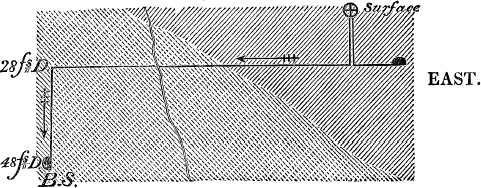
3 G 2
[page] 410
TINGTANG MINE.
On Roche's Lode.
North Underlie 12°.
Fig. 3.

On junction of Old and Middle Lodes.
North Underlie 24°.
Fig. 4.

POLDICE.
Old Ore Lode.
North Underlie 23°.
Fig. 5.

HUEL UNITY.
On William's Lode.
North Underlie 27°.
Fig. 6.

On Garby's Lode.
North Underlie 27°.
Fig. 7.

HUEL DAMSEL.
On South Lode.
North Underlie 20°.
Fig. 8.
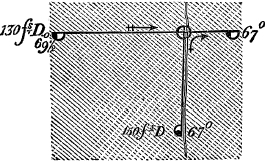
DOLCOATH MINE.
On Richard's Lode, perpendicular.
Fig. 9.

Fig. 10.

[page] 411
HUEL VOR.
On Tin Lode.
North Underlie 33°.
Fig. 11.

TRESAVEAN MINE.
On Main Lode.
South Underlie 5° to 10°.
Fig. 12.

North Lode.
South Underlie 3°.
Fig. 13.

GREAT ST. GEORGE.
South Underlie 5°.
Fig. 14.
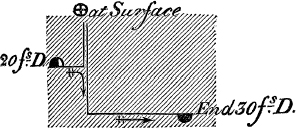
DOLCOATH.
On Caunter Lode.
South Underlie 12°.
Fig. 15.

[page] 412
DOLCOATH.
On Caunter Lode.
South Underlie 12°.
Fig. 16.

On Harriet's Lode.
South Underlie 9°.
Fig. 17.

(See intersections of these Lodes, Fig. 27.)
HUEL ROSE LEAD MINE.
Lode 3 feet wide.
South Underlie 25° to 30°.
Fig. 18.

[page] 413
Transverse sections of parallel Lodes connected by the Wires, from Fig. 19. to Fig. 26.
POLDICE MINE.
Tin Lode. Old Ore Lode (copper).
Fig. 19*.

HUEL LEISURE.
Copper Lodes.
Fig. 20.
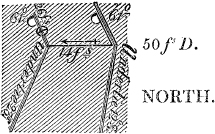
HUEL PROSPER.
Copper Lode. Lead Lode.
Fig. 21.

TRESAVEAN MINE.
Fig. 22.
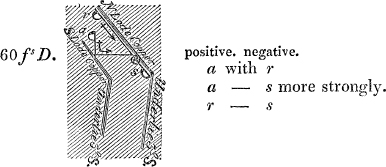
HUEL UNITY.
Copper Lodes.
Fig. 23.
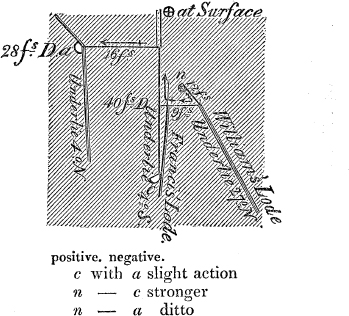
Fig. 24.

* The parts above the bends or angles in the veins or lodes are intended to represent the horizontal directions in perspective. The parts under the angles show their underlie.
[page] 414
HUEL DAMSEL.
Fig. 25.
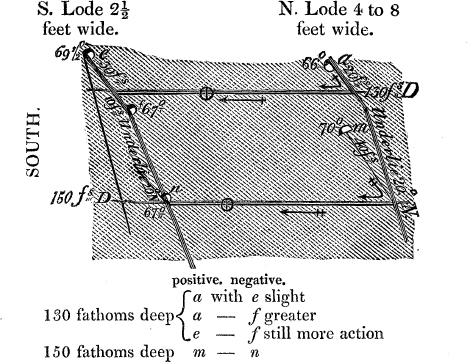
HUEL JEWEL.
Fig. 26.
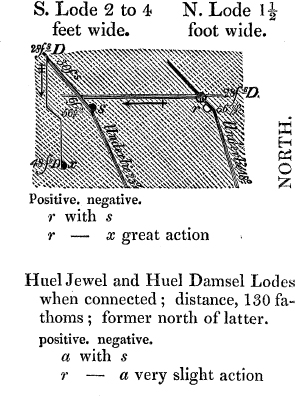
DOLCOATH MINE.
Supposed bird's-eye view of the alternate intersections of the Caunter and Harriet's Lodes, both copper.
Fig. 27.
